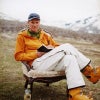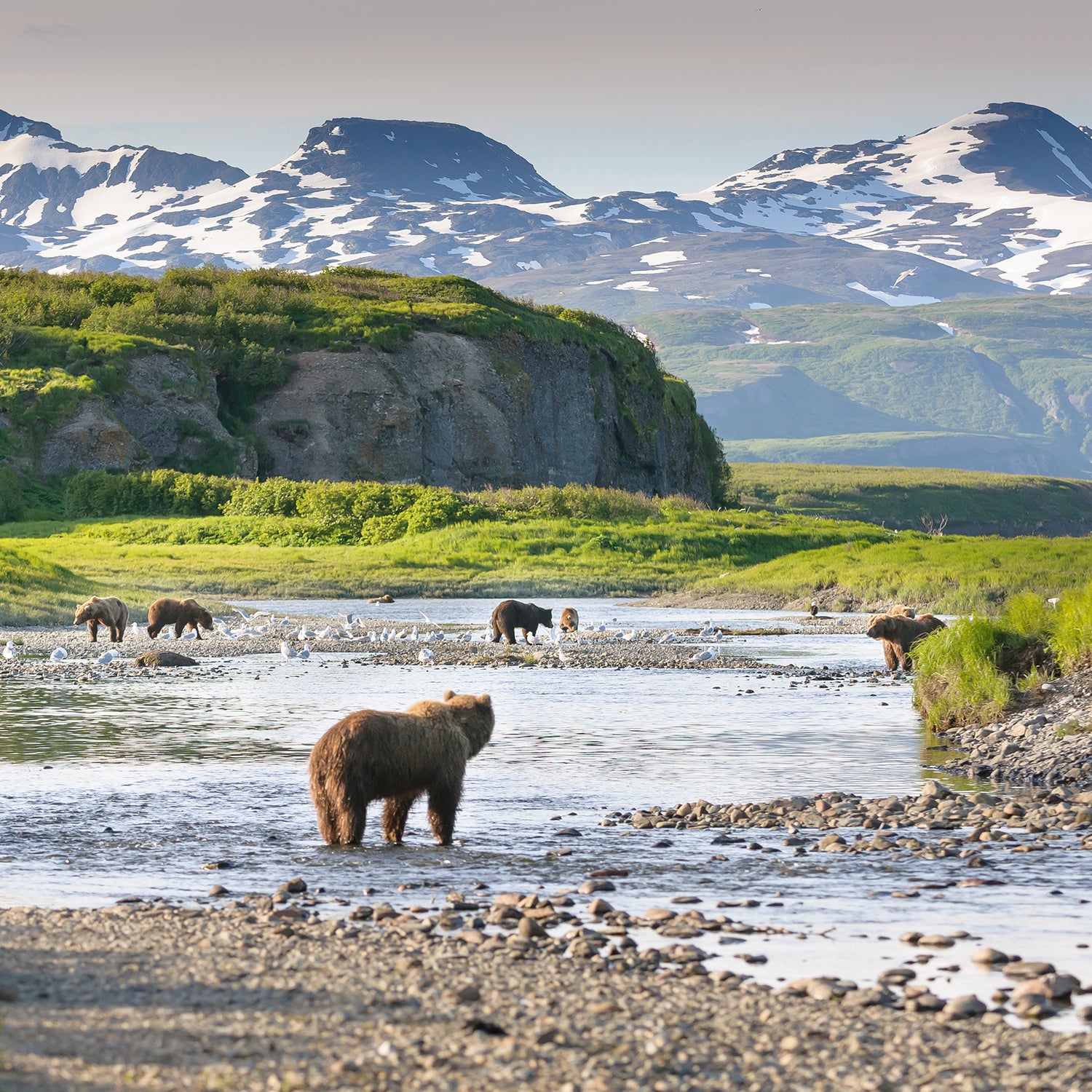There’s no place in the world like McNeil River, Alaska. In summer, you can sit beside the falls of the river and watch as 40, 50, even 70 bears mate, fight, and fish for their salmon dinner. Together. At once. Often within feet of your chair.
“We actually saw 80 bears one time at the falls—80 bears!” Larry Aumiller, the place’s legendary former manager, told me. “That’s more bears than there are in France!”��
These aren’t just any bears, mind you, but the famous,��bowel-looseningly-big brown bears of the Alaska Peninsula—that green arm of land that reaches toward Kamchatka. After feasting for weeks each summer, the most impressive males waddle away to hibernation weighing more than three NFL nose tackles. Simply put, McNeil is the largest seasonal congregation of the largest brown bears on earth.
To preserve the specialness of this place, visitors are limited to just 10 at a time, 200 people per viewing season, all of whom are chosen by lottery, with a preference toward Alaskans. The , as it’s officially called, is one of the most protected places in the entire state, and rightfully so. Now 51 years old, the 200-square-mile sanctuary and surrounding refuge are an example of real forward thinking in a state whose politicians are not often known for putting conservation ahead of resource extraction.
Now, though, love of gold threatens McNeil.
Remember Alaska’s Pebble Mine, the massive, open-pit abomination��proposed for the headwaters of two of the major rivers that feed Bristol Bay, one of the most productive salmon fisheries in the world? Remember how Pebble seemed dead, after Alaskans fought it for years?
Now Pebble is back, zombie-like, to terrorize the state’s residents and their way of life—thanks to the Trump Administration, which has yet to meet a landscape it can’t help monetize.
The Canadian-owned Pebble Limited Partnership recently submitted an application to the U.S. Corps of Engineers to tap the hugely lucrative gold, copper, and molybdenum deposit, about 200 miles southwest of Anchorage. The company has tweaked its former plans, and now proposes to connect its mine to the outside world by bulling several sections of blacktop through the wilderness—including laying down 35 miles of two-lane highway across the Alaska Peninsula east of Lake Iliamna. The road would connect to a massive new port in the east at Amakdedori Beach. To power this fandango, the company wants to lay a 188-mile natural gas pipeline under Cook Inlet. It would be an industrial corridor in the wilderness, as close as a few hundred yards away from the northern boundary of the McNeil refuge.��Late last month, the major financial investor in the Pebble Mine project����of the project. But this zombie hasn’t been killed—yet.
Pebble is back, zombie-like, to terrorize the state’s residents and their way of life—thanks to the Trump Administration, which has yet to meet a landscape it can’t help monetize.
I’m a reporter by training. I’ve been taught to keep my opinions to myself. But I’ve also spent time on the Alaska Peninsula, for this magazine and others. I McNeil River last summer. Sometimes in my reporting I come across a topic I know well, and a proposal so ill-considered, so criminally inept, that to hold the tongue is to be complicit in the destruction of something remarkable that does not belong to us.
So let’s talk a bit about bears and roads.
Bears love McNeil River. The number of brown bears here can average nearly one per square mile. Why? Habitat. There’s lots to eat��and lots of room to roam. And bears do roam. On the Alaska Peninsula, brown bear home ranges can extend as far as 100 square miles. Peripatetic males have been known to travel more than 100 miles in a single direction during one season.
Yet the bears keep returning every spring and summer to the sanctuary and its buffet of sedges, its creeks and river with their differently-timed runs of salmon. Drew Hamilton, president of ��and a former staffer at the sanctuary, likened McNeil to a “truck stop,” with big guys and gals always coming and going, sitting a spell, fueling up. The refuge managers can identify 100 different bears by sight.
The first thing you notice when you land at McNeil for a visit is the almost complete lack of a human footprint, beyond a few cabins hunkered on the shore. That’s no accident. The language establishing the sanctuary in 1967 put the welfare of the animals first, even above research or viewing. Bears aren’t even tagged here. Larry��Aumiller, who managed the place for 30 years, and his successors have been meticulous stewards of that mandate.
Here, the bears rule. And you play by their rules. The guides and small groups keep to predictable trails, at predictable times, in predictably��small groups, day after day. With the decades, the bears have grown to understand this routine. The result is that the bears see humans neither as threat, nor as source of food. They feel safe, which makes them feel comfortable, and so they let humans move closer, and they also move closer to us—sometimes very close. It’s not uncommon for a bear, sated with fish, to fall asleep right beside humans on the ground-level viewing pad at McNeil Falls. “It is the crown jewel of wildlife viewing,” says Hamilton. “I would put it on par with anything in the world.”
When I visited late last June, not yet highest season, we saw perhaps 40 bears a day. Bears were mating, wrestling, fighting, feeding. I’m not a mystical person, but when a mother bear and her cub saunter past you, not a dozen feet away, your innards feel that they have been brushed by some bright wing. This relationship of trust that has been nurtured over decades between humans and bears may be unique in the world. A few days spent at McNeil will make you recalibrate how it is possible for humans to find their place again in the natural world.
But this relationship is seriously threatened by the mining company’s proposal. The transportation corridor proposed by the company “literally kisses the edge” of the refuge, Aumiller says.��
Here’s why that matters: As we said, bears roam. The bears that come to McNeil later disperse. Some will head north, some��west. They will encounter the road, and people on that road. After all, it will be built through prime bear habitat, where there is nothing else��right now.
Roads fragment a landscape. They fracture habitat. They bring in other influences and invasive species. They encourage other roads, and still more human development. Many .��Most of all, they will change the way the bears interact with humans. “Most of the bears, the only humans they experience is us. And that’s gonna change” with a road, Aumiller told me.
Hamilton added, “The sanctuary is going to be giving out one message, the same one it’s been giving out for 50 years, and then you have this industrial complex that is going to be giving out the complete opposite message. They’re going to be hazing bears. They’re going to be hitting bears with trucks. In some cases, bears are going to become food-conditioned.”
Roads fragment a landscape. They fracture habitat. They bring in other influences, and invasive species. They encourage other roads, and still more human development.
There will be more hunting��and more poaching, these critics predict. All of this adds up to bears that are more uncomfortable around humans. And that means the dynamic at McNeil River—a balance between human and bear—will change irrevocably. “They’ll stay away,” Aumiller said of some of the bears. And those who do return possibly will avoid us.
This change, said Hamilton, also could reduce safety at McNeil, a place where no one has been injured or killed by a bear, and no bear killed by a visitor, in the more than four decades since the permit system went into effect.
And yet: in its application, the mining company��doesn’t once mention McNeil River, or its bears.��
One could write a chapter-book on the breathtaking array of additional bad ideas contained within the new Pebble Mine application. (Here’s another: the destruction of gorgeous Amakdedori Beach to dredge and build a deepwater port and airstrip that would be seen from bear-viewing spots within the sanctuary.) For an overview of the whole proposal, check out , and also for more critique.
“What can I do?” you ask.
Submit a comment to the Corps of Engineers by June 29. Tell the Corps that the project’s impacts on the world-class population of bears, and the unique McNeil Sanctuary, must be considered in an assessment.
Next, contact Alaska’s senators, and and voice your opinion about the mine’s route and its effects.
Don’t give a foreign mining company the last word on the future of your country. You may never get to McNeil River. But as Wallace Stegner said of wilderness, sometimes it’s enough just to know that places like this still exist—whole and untamed, and apart from us.


